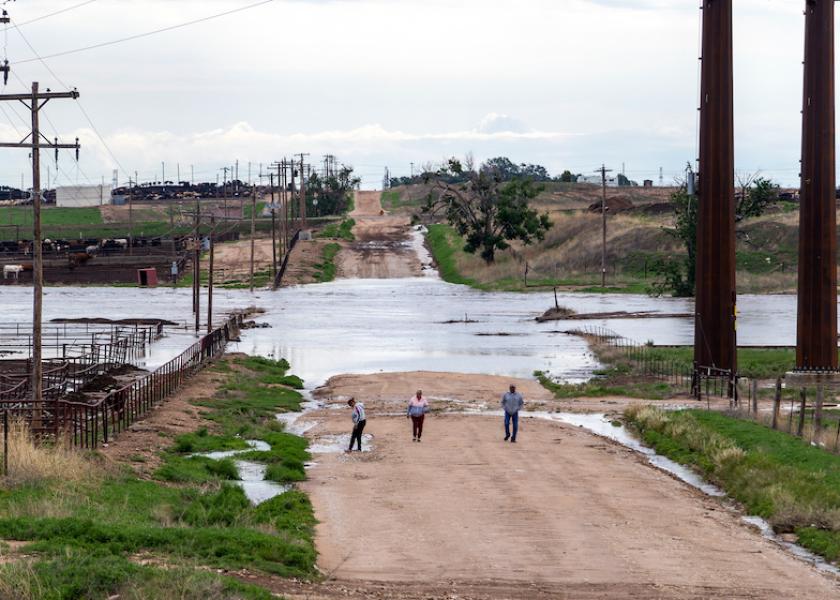Flash Flooding Hits Texas Panhandle, Several Feedyards Now Face Massive Cleanup and Cattle Losses

From drought to now major flooding, historic rainfall fell in the Texas Panhandle over the weekend and prompted flooding. Hereford, Texas, is an area that was hit especially hard by the historic rains, with feedyards flooded and cattle trapped. Now, work is underway to pump a massive amount of water out.
According to the National Weather Service in Amarillo, the Hereford, Texas, area unofficially received 8 inches of rain in the past month. The heaviest rainfall event came Friday morning, with some volunteer observers showing 2.45 inches of rain fell in just 40 minutes.
@NWSAmarillo US Highway 385 is now being overtopped in the south side of Hereford. Water has come up approximately 5 feet in the last 30 min. Taken 9:20am pic.twitter.com/Gb1wCh49sT — Brady Kendrick (@BradyKendrick24) May 27, 2023
According to John Robinson, senior vice president of membership and communications for the National Cattlemen’s Beef Association (NCBA), the water simply had nowhere to go, which prompted the flooding around Hereford. With such a quick rainfall event, there also wasn’t any advance notice that would have allowed residents to prepare.
“It’s flat topography down there. Once those creek beds that have been really dry for years fill up, there's no place for that water to go. So that water spills over into low-lying areas adjacent to those creek beds. And it's really caused a problem around the Hereford-Amarillo area down in the panhandle of Texas,” says Robinson.
The flooding impacted residential areas, and from an agricultural perspective, Hereford is also a major cattle production area and home to several feedyards.
“It's one of the largest cattle feeding areas in the United States, so there are definitely widespread impacts,” says Robinson. “There's probably going to be some production losses, some performance losses in terms of rate of gain, things like that.”
FLOODING IN HEREFORD continues. All of this water is headed to Buffalo lake and if/when it is full, the rest will head towards Palo Duro Canyon. Here is some video from @DowningMitchell #txwx #flooding #heavyrain @ABC7Amarillo @StormSearch7 @natwxdesk @NWSAmarillo pic.twitter.com/oLXi3x1AHU — Corbin Voges WX (@CorbinVogesWX) May 27, 2023
Robinson points out while the short-term impact is painful for any feedyard dealing with the flooding, he says it shouldn’t create a big impact on cattle supply longer-term.
“It's mostly going to work its way out here in the next few days,” he says. “There shouldn't be supply chain increases, there shouldn't be significant price increases. Who knows what else might happen in the meantime, but the impacts are going to be relatively short-lived for the vast majority of these areas.”
Major flooding in Hereford, TX following the overnight storm. Houses, cars, and semi-trucks under water as authorities work to divert citizens from the area. @ABC7Amarillo @StormSearch7 pic.twitter.com/GzY48iKqK7 — Mitchell Downing (@DowningMitchell) May 27, 2023
Some rumored estimates over the holiday weekend claimed 25,000 head of cattle died in the flooding, but NCBA says its representatives are in constant conversation with several producers in the area, and those estimates are way too high. NCBA says everyone is still trying to get a handle on losses, but it’s a fraction of the 25,000 number being thrown around.
Robinson says feedyards around Hereford are getting creative in pumping water out and cattle to dry ground.
“On one yard in particular, they brought in some dewatering pumps from oil drilling sites, maybe as far away as New Mexico. They're pumping that water out, in some cases, over a mile to get it off of the feedyard so they can dry things out, get cattle to a safe, dry place to bed down,” he says.
Most of the water has receded in the Hereford area, but Robinson says there will be a lot of clean-up work that follows.
“While they're trying to get all this other work done, they're getting fences repaired, VDR pens repaired and dried. And it's a lot of work. But there's a committed crew of folks down there doing it, and not just from the agriculture industry, but from oil and gas and others as well,” says Robinson.
More precipitation could be on the way. Forecasts point to more severe weather—and heavy rains—which could cause further flooding.







